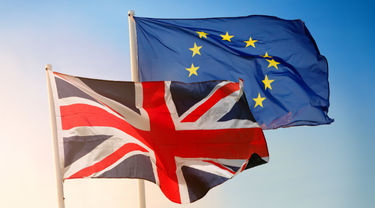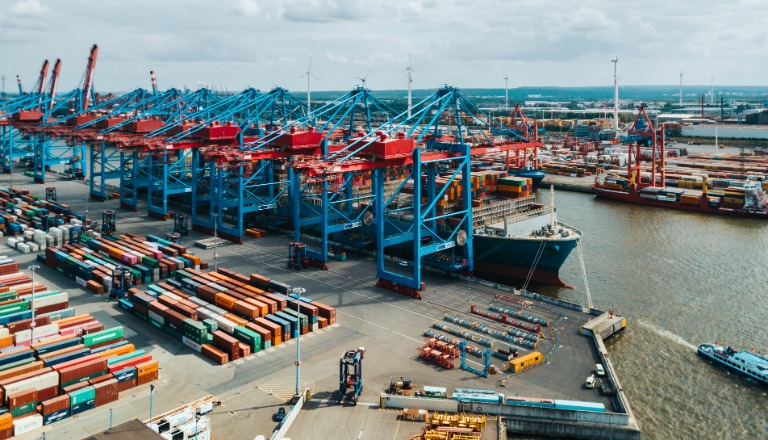In 2017, Canada and the European Union (EU) signed an historic free trade treaty designed to smooth the flow of goods and services across the Atlantic. The Canada-European Union Comprehensive Economic and Trade Agreement (CETA) solidified the already strong ties between Canada and the diverse countries within the EU.
After Brexit (the United Kingdom’s withdrawal from the European Union), the Canada-United Kingdom Trade Continuity Agreement (Canada-U.K. TCA), signed in 2021, preserved the benefits of CETA for trade between the two countries.
Since then, CETA and the Canada-U.K. trade agreement have been the backbone of bilateral trade between Canada and Europe. In 2024, Canada exported $34 billion to the EU, an increase of 57% from pre-CETA trade in 2015, despite headwinds from slow growth and falling commodity prices. The U.K. is Canada’s third-largest trading partner for goods and services, with trade valued at $61 billion in 2024.
Fast-forward to 2025, and this open door to 450 million affluent consumers is getting fresh attention from Canadian companies looking to diversify in the face of growing market uncertainty.
“We’ve been flooded with calls from companies looking for help entering new markets,” says Bruce Dunlop, Export Development Canada’s (EDC) regional vice-president for Europe. “In the current environment, Canadian companies have realized that diversifying their export markets is no longer just a nice to have. It’s essential for them to survive and thrive. Starting in markets where we have free trade agreements makes perfect sense.”
Beyond the nearly tariff-free access Canadians have under CETA and the Canada-U.K. trade agreement, European markets offer advantages like stable regulatory regimes, strong adherence to the rule of law and familiar business practices. Europe and Canada share many core values, like our commitments to combating climate change, protecting human rights and promoting diversity. English is used as a second language across the continent and French is also widely spoken.
While it’s not as close as the United States, “getting your goods to Europe from Canada is a lot less difficult than it looks on the map,” Dunlop says, thanks to frequent air connections and shipping routes.
For companies considering market diversification in Europe, this article summarizes key facts and benefits of CETA and the Canada-U.K. Trade Continuity Agreement.
Since the world’s first recorded free trade agreement—the 1860 Cobden-Chevalier Treaty—was signed between France and Britain, FTAs have become the cornerstone of open global trade. Designed to reduce or eliminate barriers to trade such as tariffs, quotas and import restrictions between countries or within regions, they aim to promote economic growth and strengthen trade relations by fostering the free flow of goods and services across borders. FTAs often include provisions on intellectual property (IP) rights, investment protections and dispute resolution mechanisms, ensuring a stable and predictable trading environment.
Canada currently has 15 FTAs covering 61% of the world’s gross domestic product (GDP). Canada’s FTAs with 51 other countries have opened markets for key Canadian industries such as agriculture, automotive and technology, while also providing Canadian consumers with greater access to a variety of goods at competitive prices, says Lili Mei, an economist and country risk analyst at EDC.
“Diversifying is important regardless of the economic era. With Europe, we have very strong people-to-people ties. We have CETA and, in terms of social values, we share languages, we align in many ways, especially in cleantech and resources development,” she says. “Canada has long-established trade relations with the EU, especially when they have strong needs, like their energy crunch.”
In an era of rising protectionism and trade restrictions, FTAs are a critical tool for exporters to mitigate the risks associated with market concentration, adds Sasan Fouladirad, EDC country risk analyst and economist.
“Over-indexing in one market is a risk given that there’s so much protectionism. Expanding our network of FTAs not only strengthens Canada’s global trade position, but could also increase innovation and competitiveness by exposing businesses to diverse markets and new opportunities,” he says.
Having multiple FTAs, like CETA and Canada-U.K. TCA, means Canadian businesses can work with a wide range of open and more co-operative trade partners, reducing vulnerability to unilateral trade policies.
CETA was built on the shared goal of strengthening economic ties between Canada and the EU by enhancing bilateral market access. It includes provisions on eliminating 99% of tariffs, establishing favourable rules of origin, easing customs and trade facilitation, increasing regulatory co-operation and accommodating trade in services and labour mobility. Overall, it fosters economic growth, diversifies trade partnerships and provides Canadian businesses with preferential access to one of the world’s largest markets.
CETA: Main provisions
Key highlights include:
- Trade in goods: Under CETA, 99% of EU tariff lines are duty-free for Canadian goods, compared to 25% in the pre-CETA era.
- Rules of origin: CETA establishes clear and favourable rules of origin, ensuring products with Canadian inputs are recognized as originating from Canada and therefore, entitled to preferential treatment.
- Customs and trade facilitation: The agreement simplifies customs procedures and reduces processing times at borders. This provision benefits Canadian exporters by ensuring faster and more predictable movement of goods, reducing delays and associated costs and enhancing supply chain efficiency.
- Regulatory co-operation and conformity assessment: This provision allows collaboration between Canadian and EU regulators to align standards and avoid unnecessary regulatory barriers.
- Government procurement: Canadian companies have access to EU government procurement markets at all levels, which could lead to an estimated $3.3 trillion in business.
- Trade in services and labour mobility: This provision allows Canadian service providers and skilled labour such as engineers, information technology (IT) specialists and consultants to work more freely in the EU.
- Investment: Under CETA, investors have greater certainty, stability and protections, like the inclusion of an independent dispute mechanism.
- Sustainable development, labour and the environment: CETA upholds Canada’s environment and labour standards and confirms the right to regulate for all levels of government.
- Intellectual property: CETA includes provisions for IP rights, including geographical indications, or where a product is produced.
You should also check out
How Canadian exporters can reduce trade risks and successfully enter high-growth European markets.
Since CETA was implemented, trade in goods and services between Canada and the EU has risen steadily. Canadian merchandise exports increased 51.1%, from $22.9 billion in 2016 to $34.6 billion in 2024. In 2024, bilateral merchandise trade reached approximately C$118 billion (Source: Statistics Canada).
Through CETA, an estimated $890.6 million in tariffs were saved in 2021 alone.
Several Canadian industries have benefited through access to the EU market. Trade for key sectors that have experienced the most growth since implementation include aluminum and related metals (up 378%), motor vehicles and parts (up 89%) and mineral fuels and oils (up 84%).
EDC’s market intelligence for Europe also highlights high potential in several key sectors, including agri-food, infrastructure, cleantech and decarbonization, renewables and energy.

Exports to the EU have increased in several sectors, but also to specific countries.
Germany
Canadian businesses sent $5.7 billion in goods to Germany in 2024, including:
- Aircraft and other transportation equipment and parts: $524 million
- Basic and industrial chemical, plastic and rubber products: $241 million
- Consumer goods: $753 million
- Electronic and electric equipment and parts: $584 million
- Energy products: $1.13 billion
- Farm, fishing and intermediate food products: $295 million
- Forestry products and building, packaging materials: $142 million
- Industrial machinery, equipment and parts: $462 million
- Metal and non-metallic mineral products: $655 million
- Metal ores and non-metallic minerals: $732 million
- Motor vehicles and parts: $121 million
Source: Haver Analytics, EDC Economics
France
In 2024, Canadian businesses exported $3.9 billion to France, including:
- Aircraft and other transportation equipment and parts: $1.1 billion
- Basic and industrial chemical plastic and rubber products: $101 million
- Consumer goods: $433 million
- Electronic and electric equipment and parts: $370 million
- Energy products: $713 million
- Farm, fishing and intermediate food products: $255 million
- Forestry products, building and packaging materials: $54 million
- Industrial machinery, equipment and parts: $258 million
- Metal and non-metallic mineral products: $68 million
- Metal ores and non-metallic minerals: $547 million
- Motor vehicles and parts: $37 million
Source: Haver Analytics, EDC Economics
Italy
Exports from Canada to Italy totalled $3.1 billion in 2024, including:
- Aircraft and other transportation equipment and parts: $821 million
- Basic and industrial chemical plastic and rubber products: $56 million
- Consumer goods: $532 million
- Electronic and electric equipment and parts: $185 million
- Energy products: $0.5 million
- Farm, fishing and intermediate food products: $910 million
- Forestry products, building and packaging materials: $56 million
- Industrial machinery, equipment and parts: $195 million
- Metal and non-metallic mineral products: $292 million
- Metal ores and non-metallic minerals: $64 million
- Motor vehicles and parts: $10 million
Source: Haver Analytics, EDC Economics
When the U.K. ended its membership in the EU in January 2020 following the Brexit vote, it also left behind multilateral FTAs, like CETA, creating the need for new or renegotiated trade blocs to fill the gap. Amongst those was the Canada-United Kingdom Trade Continuity Agreement (Canada-U.K. TCA). Effective from April 2021, the Canada-U.K trade agreement largely replicates CETA’s provisions, ensuring stability, predictability and safeguards against trade disruptions.
Since implementation, trade between Canada and the U.K. has increased dramatically. In 2024, the U.K. reported a 15.7% increase in imports from Canada, amounting to $2.58 billion, making Canada the U.K.’s 16th-largest trading partner. Another $56 billion was invested by Canadian companies through foreign direct investment, ranking it as the third-largest recipient country for Canadian investment abroad.
The new Canada-U.K. trade agreement largely duplicates CETA, with a few other benefits:
- Tariff elimination: The Canada-U.K. TCA initially eliminated tariffs on 98% of goods traded between Canada and the U.K. but increased to 99% in January 2024.
- Protections: It protects Canada’s dairy, poultry and egg industries.
- Regulatory co-operation: The regulatory co-operation provisions in the Canada-U.K. TCA aim to reduce technical barriers to trade by aligning standards and fostering collaboration between Canadian and U.K. regulators. This reduces duplicative testing, certification processes and compliance costs for exporters, making it easier for Canadian products to enter the U.K. market.
- Customs and trade facilitation: Like CETA, the TCA includes assurances that respective customs and border practices remain clear, predictable and simple to reduce processing times and keep trading costs low.
- Preferences for exporters of services: The agreement ensures continued access to the U.K. for Canadian service companies, contractors and government procurement, which is estimated to be worth $118 billion.
- Investment protections: Designed to attract foreign investment, these provisions include important investor protections and dispute resolution mechanisms.
The U.K. has always represented a vibrant and diverse market of opportunity for Canadian businesses dating back to 1867 when the British kingdom was Canada’s largest trading partner. Agri-food, beverages, cleantech, infrastructure and transportation and forestry products are all now part of Canada’s trade envelope. The Top 5 exported services covered the sectors of business, travel, transportation, financial, telecommunications and information services. EDC’s Market of opportunity: Doing business in the United Kingdom has key insights to support exporters.
In 2024, Canada sent $27.0 billion in exports to the U.K. Some of our leading exports by dollar value include:
- Aircraft and other transportation equipment and parts: $659 million
- Basic and industrial chemical plastic and rubber products: $218 million
- Consumer goods: $647 million
- Electronic and electric equipment and parts: $454 million
- Energy products: $1.4 billion
- Farm, fishing and intermediate food products: $747 million
- Forestry products, building and packaging materials: $232 million
- Industrial machinery, equipment and parts: $399 million
- Metal and non-metallic mineral products: $21.9 billion
- Metal ores and non-metallic minerals: $186 million
- Motor vehicles and parts: $50 million
Source: Haver Analytics, EDC Economics
EDC is committed to helping Canadian companies diversify into new markets and succeed in this dynamic region. Our support includes in-country representation to support new ventures, financial solutions and trade insights. EDC also offers:
- A full suite of credit insurance products to lower your risk for doing business abroad
- Help with getting access to working capital
- Expertise to enable you to learn more about international markets
- Connections to international companies in need of your products and services
Canada’s Trade Commissioner Service (TCS) also has a highly qualified team of trade commissioners across 27 European markets ready to help.
Learn more about how EDC’s financial and knowledge solutions can help you understand the opportunities in your target market and make exporting less risky. To contact an EDC export advisor, visit our Export Help Hub and sign up for a free MyEDC account.
Interested in growing your business in Europe? Connect with EDC and watch your business flourish on the international stage.
Answer a few questions about your company to learn more about how EDC can help you plan, connect and fuel your global expansion.





